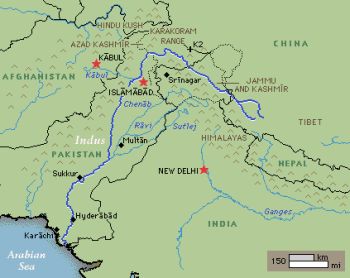The Indus Valley Civilization
From 25000 to 1700 BC, the Indus River irrigated the lands of a very articulated civilization that once thrived in a/ around the present day remains of Mohenjo Daro and Harapa. |
The Indus Basin Water Treaty
At the time of partition, all water heads of rivers flowing in Pakistan went to India, thus seriously affecting the just distribution of water between the two countries. After hectic negotiations, the Indus Basin Water Treaty was signed between Pakistan and India in September 1969, in which the Bank had been an intermediary.
|

Archives - Bridge on Indus

Indus as viewed from satellite

Indus Delta
 If there was no Indus river, there would not have no people living in this part of the world.
Originating from the glacial Tibetan mountains, the Indus gushes in to Pakistan with all its might and fright from the northern areas. Near Attock, the River Kabul also joins this
ferocious river and one can
vividly see the blue Kabul River merging with the muddy Indus while standing on the bridge over Indus at Attock. Both join hands together and irrigate the entire length of Pakistan, approximately 2,900 km (1,800 mi), till it steadily calms down and fades away in the Arabia Sea.
If there was no Indus river, there would not have no people living in this part of the world.
Originating from the glacial Tibetan mountains, the Indus gushes in to Pakistan with all its might and fright from the northern areas. Near Attock, the River Kabul also joins this
ferocious river and one can
vividly see the blue Kabul River merging with the muddy Indus while standing on the bridge over Indus at Attock. Both join hands together and irrigate the entire length of Pakistan, approximately 2,900 km (1,800 mi), till it steadily calms down and fades away in the Arabia Sea.
 Besides Indus, four other rivers also enter Pakistan from the neighbouring India, namely the Jhelub, Chenab, Ravi and Sutlej and all empty into the Indus to add to its might and power. The place where all these four rivers meet the Indus is known as "Panj Nadh (meaning in local language Five Rivers) south of the famous ancient city of Multan.
Besides Indus, four other rivers also enter Pakistan from the neighbouring India, namely the Jhelub, Chenab, Ravi and Sutlej and all empty into the Indus to add to its might and power. The place where all these four rivers meet the Indus is known as "Panj Nadh (meaning in local language Five Rivers) south of the famous ancient city of Multan.
Having almost lost its impetus near the Arabia Sea, it fans out and forms the Indus Delta. Here the forests of mangroves and many a species of birds and fish flourish on the sweet waters of the Indus. The total area of the
deltas that includes swamps and mangroves is approximately 225,000 hectares (556,000 acres). The port city of Karachi and marches of Ran of Kutch shoulder this delta during its final stages of journey.
See More..

Cities that Indus Passes By: The Indus skirts and
passes by the famous Attock, Bannu, Faisalabad, Multan, Khairpur, Sukkur, Larkana, Nawabshah, Mirpurkhas,
Hyderabad and finally embracing the Arabian Sea near the port city
of Karachi (above).
The Indus Delta The Indus Delta is the fifth largest delta
in the world, characterized by high river discharge, moderate tides, and
evidently the highest wave energy of any river in the
world. The fan-shaped delta consists of creeks, estuaries, mud,
sand, salt flats, mangrove habitat, marshes, sea bays, and straits and rocky
shores. Its 129,000 ha. of mangrove, mostly Avicenna marina, comprises 97%
of the total mangrove area in the country and is said to be the
7th largest mangrove forest in the world.
The area is rich in archaeological and religious heritage.
The Indus River "Blind" Dolphin


The Indus River harbours the rare species of nearly blind dolphin. The dolphin lacks eye lenses and the eye openings are no bigger than a pinhole. As a result, these rely almost entirely on echolocation to forage for food and navigate in the murky river waters.
The Indus
Dolphin has a long beak, a small, low hump, wide flippers and an adult can weigh 70- 90 kg. They are slow swimmers, but can move in rapid spurts. They breathe through their slit - like blowholes with a loud sound that is similar to a sneeze, and can be heard from quite a distance." It sometimes carries its young on its back, above the surface of the water.
These are found in a localized 100 mile stretch between the Sukkur and Guddu Barrages in Indus River. The dolphin, also known as Indus Susu, is one of the five species of cetaceans that are threatened with extinction, presently no more than 500 animals remaining.
The Indus dolphin has been a victim of both deliberate and accidental exploitation. The Pakistan Adventure Foundation, a project funded by the UN Development Programme, is trying to create awareness about the endangered blind dolphin through rafting expeditions and visiting riverside fishing communities.


